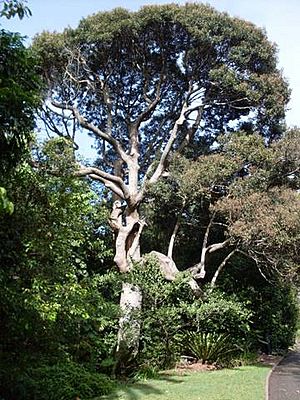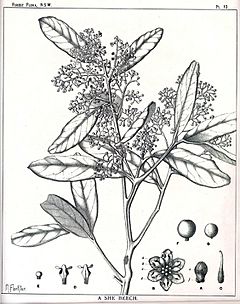Cryptocarya obovata facts for kids
Quick facts for kids Cryptocarya obovata |
|
|---|---|
 |
|
| Cryptocarya obovata at the Royal Botanic Gardens, Sydney | |
| Scientific classification | |
| Genus: |
Cryptocarya
|
| Species: |
obovata
|
Cryptocarya obovata is a tall laurel tree that grows in the rainforests of eastern Australia. It likes to grow in areas with rich soil, like those formed from basalt rock or river deposits. You can find this tree from Wyong in New South Wales (which is about 33° South latitude) up to Gympie in Queensland (around 27° South latitude). It used to grow in the Illawarra region (34° South), but it's not found there anymore. Someone named Allan Cunningham reportedly saw it in Illawarra in 1818. This tree was officially described in a book called Prodromus Florae Novae Hollandiae et Insulae Van Diemen in 1810.
Contents
What is the Pepperberry Tree?
Cryptocarya obovata is also known by its common names: the pepperberry or white walnut. This impressive tree can grow very tall, reaching up to 40 metres high. Its trunk can also become quite wide, up to 90 centimetres across! If you look at the tree from below, the underside of its leaves looks a bit rusty because they are covered in tiny hairs.
Trunk, Bark, and Leaves
The trunk of the pepperberry tree is usually straight and round. It often has buttress roots at the bottom, which are like wide, flat supports that help keep the tree stable. The bark is typically grey or brown and feels quite smooth. You might also see vertical lines of small bumps, called pustules, on the bark.
The leaves grow alternately along the branches. They are shaped like an upside-down egg or are oblong, usually between 6 and 12 centimetres long. The tip of each leaf is rounded. The top surface of the leaf is smooth and shiny, while the underside is often greyish and covered with fine hairs. The leaf stalks, which connect the leaf to the branch, are brown and about 3 to 8 millimetres long.
The veins on the leaves are very easy to see. The main vein (midrib) and the side veins are raised and covered with brown hairs, making them stand out. These veins can be brownish-orange or yellow in colour.
Flowers, Fruit, and Growing New Trees
The pepperberry tree produces cream-coloured flowers that grow in clusters called panicles. Each individual flower is quite small, about 3 millimetres long, and has almost no stalk. These flowers usually appear between February and May.
The fruit of the pepperberry tree is a black, round drupe. A drupe is a type of fruit with a fleshy outer part and a hard shell (or "stone") inside that contains the seed. The fruit is usually ribbed and about 12 millimetres across. The seed inside is about 8 millimetres in diameter. The fruit ripens from March to May. Many birds enjoy eating these fruits, including the Australasian figbird, the rose-crowned fruit-dove, the topknot pigeon, and the wompoo fruit dove.
If you want to grow new pepperberry trees from seeds, it's a good idea to remove the fleshy part of the fruit (called the aril) before planting. This helps the seeds sprout. Growing Cryptocarya obovata from seed can be a bit slow. After about 205 days (which is over six months!), you can expect about half of the seeds to have successfully germinated.
Gallery
-
Cryptocarya obovata at the Royal Botanic Gardens, Sydney
See also
 In Spanish: Cryptocarya obovata para niños
In Spanish: Cryptocarya obovata para niños






